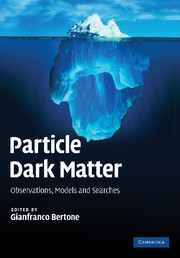Book contents
- Frontmatter
- Contents
- List of contributors
- Preface
- Acknowledgements
- List of symbols and abbreviations
- Part I Dark matter in cosmology
- Part II Candidates
- Part III Collider searches
- Part IV Direct detection
- 17 Direct detection of WIMPs
- 18 Annual modulation signature with large mass highly radiopure NaI(Tl)
- 19 Particle dark matter and the DAMA/NaI and DAMA/LIBRA annual modulation effect
- 20 Cryogenic detectors
- 21 Liquid noble gases
- 22 Directional detectors
- 23 Axion searches
- Part V Indirect detection and astrophysical constraints
- References
- Index
21 - Liquid noble gases
Published online by Cambridge University Press: 04 August 2010
- Frontmatter
- Contents
- List of contributors
- Preface
- Acknowledgements
- List of symbols and abbreviations
- Part I Dark matter in cosmology
- Part II Candidates
- Part III Collider searches
- Part IV Direct detection
- 17 Direct detection of WIMPs
- 18 Annual modulation signature with large mass highly radiopure NaI(Tl)
- 19 Particle dark matter and the DAMA/NaI and DAMA/LIBRA annual modulation effect
- 20 Cryogenic detectors
- 21 Liquid noble gases
- 22 Directional detectors
- 23 Axion searches
- Part V Indirect detection and astrophysical constraints
- References
- Index
Summary
Noble liquids for dark matter detection
Noble liquids, specifically liquid xenon (LXe), liquid argon (LAr) and liquid neon (LNe), are excellent scintillators and, with the exception of LNe, also very good ionizers in response to the passage of radiation, thus providing an excellent alternative to cryogenic detectors (see Chapter 20). The possibility of simultaneously detecting ionization and scintillation signals in LXe and LAr is a unique feature of these liquids compared with other detection media. This capability, together with the promise of scale-up to large mass at a modest cost compared with semiconductors, has contributed to make LXe and LAr popular targets and detectors for rare physics events such as those associated with dark matter, solar neutrinos and neutrinoless double beta decay interactions. In this section, we first describe the ionization and scintillation mechanism in noble liquids, including recent measurements of the relative scintillation efficiency and ionization yield for nuclear recoils, relevant for dark matter searches. We then describe the background rejection capability of noble liquids, based on pulse shape discrimination of the scintillation light and the ratio between ionization and scintillation signals (S2/S1). At the end of the section, we briefly discuss the key requirement for ultra-high purity of noble liquids for dark matter detection.
Physical properties of noble liquids
Table 21.1 summarizes the physical properties of the three noble liquids being used or planned to be used for dark matter direct detection.
- Type
- Chapter
- Information
- Particle Dark MatterObservations, Models and Searches, pp. 413 - 436Publisher: Cambridge University PressPrint publication year: 2010
- 6
- Cited by

